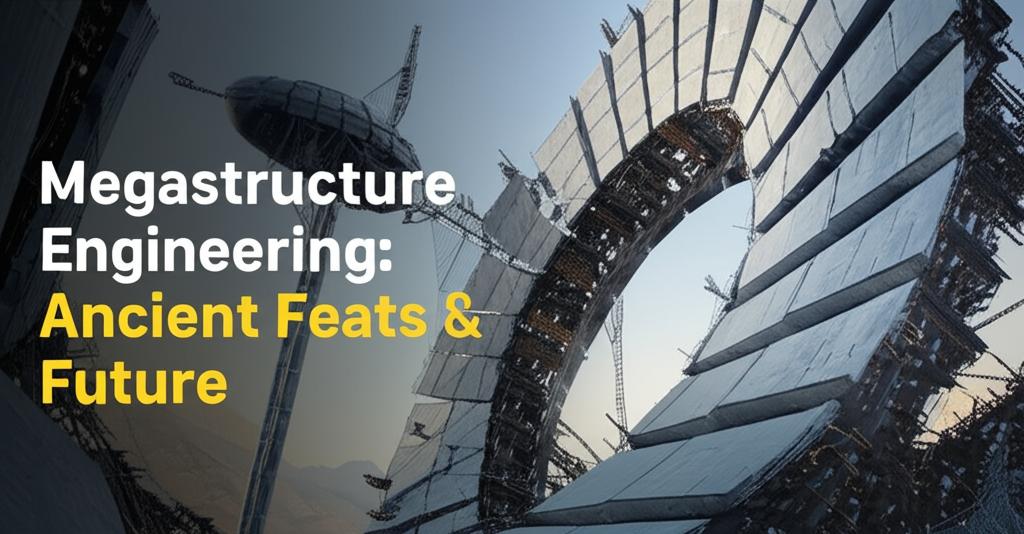From the colossal stone wonders of antiquity to the mind-bending concepts of future cosmic-scale constructions, megastructure engineering has perpetually mirrored humanity's ambition and technological prowess. These immense undertakings are not merely about scale; they represent the pinnacle of engineering skill, resource management, and often, a civilization's deepest aspirations.
Ancient peoples, with rudimentary tools yet profound ingenuity, erected structures that continue to inspire awe. The Great Pyramids of Giza in Egypt, the Roman Colosseum, and the Great Wall of China stand as testaments to their advanced understanding of materials, logistics, and societal organization. The Borobudur in Indonesia, the world's largest Buddhist temple, took an estimated 75 years to complete, showcasing the dedication and skill of its builders. These early architects and engineers mastered the art of quarrying, transporting, and assembling massive stones, creating enduring monuments that have shaped our understanding of history.
The Industrial Revolution marked a pivotal moment, introducing new materials like advanced steel alloys and high-strength concrete, alongside innovative construction techniques. This era birthed iconic structures like the Brooklyn Bridge and the Eiffel Tower, paving the way for the skyscrapers that now define modern cityscapes. The 20th and 21st centuries have witnessed an explosion in megastructure construction, pushing the boundaries of height, complexity, and material science. The Burj Khalifa, soaring over 828 meters, exemplifies modern achievements through its buttressed core system for stability and aerodynamic shaping to counter wind forces. Similarly, China's Three Gorges Dam, the world's largest hydroelectric dam, and the Beijing Daxing International Airport highlight contemporary engineering capabilities on a massive scale.
Modern megastructures, including towering skyscrapers, expansive bridges, intricate tunnel systems like the Channel Tunnel, and colossal stadiums, all present unique engineering challenges. Foundations must bear immense loads, materials must withstand extreme pressures, and designs must account for environmental factors like wind and seismic activity. Technology plays a crucial role in overcoming these hurdles, with innovations like Building Information Modeling (BIM) for 3D visualization and planning, drones for site inspection, and advanced machinery for material transport and assembly.
Looking ahead, the evolution of megastructure engineering points towards even more ambitious and transformative projects. Concepts that once seemed confined to science fiction are now being seriously considered. Space elevators, designed to connect Earth to orbit and revolutionize space travel, are a tantalizing prospect. Underwater and floating cities offer potential solutions to rising sea levels and land scarcity.
Further into the future, the realm of megastructures expands into the cosmos. Ideas like Dyson swarms or spheres, designed to encapsulate a star and harness its total energy output, represent the ultimate in energy harvesting and civilizational advancement. Orbital habitats like O'Neill Cylinders or Stanford Toruses could provide large-scale living environments in space. Other futuristic concepts include planetary shields for defense, ringworlds, and even stellar engines capable of moving entire star systems. The development of such structures would necessitate breakthroughs in robotics, automation, advanced space transportation, and materials science. Artificial intelligence would also play a critical role in the design, construction, and maintenance of these complex systems.
While some research explores the feasibility of moving existing planets into habitable zones as an alternative to building massive new structures, the drive to design and construct on a grand scale persists. The journey from ancient wonders to futuristic visions underscores a continuous human endeavor: to build bigger, to reach further, and to reshape our environment in increasingly profound ways. The field of megastructure engineering, therefore, remains a critical indicator of our technological progress and our enduring ambition to turn the seemingly impossible into reality.

